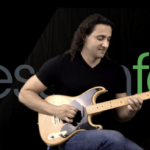Intervals Theory Part 3: The Mystery Behind Compound Intervals

As guitar players, generally, we learn a few chords, play a few tunes, buy more gear and even join a band before understanding much about music theory. As we get better most of us start to get curious about how things work and start to study some music theory. We work hard and we start to get good about understanding the basics but things can become very frustrating when we see that Cadd13 chord and have no idea how to play it.
Well, If you have been keeping up with our interval studies we have learned so far the following intervals: 2nds, 3rds, 4ths, 5ths, 6ths, 7ths and octaves; and if you have not make sure to click on part number 01 and 02 of this series.
Above the octave we will have more intervals! Yes, we will – ninths, tenths, elevenths and so on. Those intervals are called COMPOUND INTERVALS because they combine an octave with a smaller interval. So compound intervals are nothing more than the intervals that we have already studied plus an octave!
Here is a chart with those intervals:
| Interval | Combines |
| Ninth Tenth Eleventh Twelfth Thirteenth Fourteenth |
Octave plus second Octave plus third Octave plus fourth Octave plus fifth Octave plus sixth Octave plus seventh |
Compound intervals can have all the qualities of smaller intervals, which means a compound interval can be major, minor, perfect, augmented or diminished.
Examples:
| Cadd9 C E G + D (one octave higher) | Cadd13 C E G + A (one octave higher) |
| E---0---- B---3---- G---0---- D---2---- A---3---- E-------- |
E---5---- B---5---- G---5---- D---5---- A---3---- E-------- |
Stay tuned for more on this series and don’t forget to contact me with any questions!
Related:




